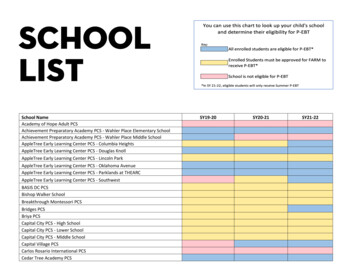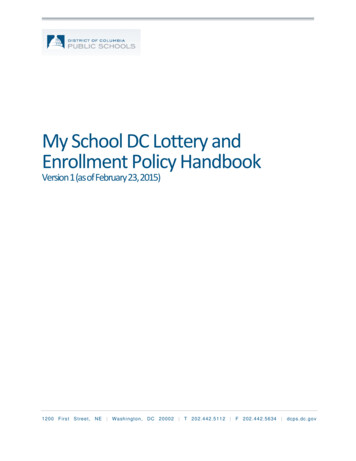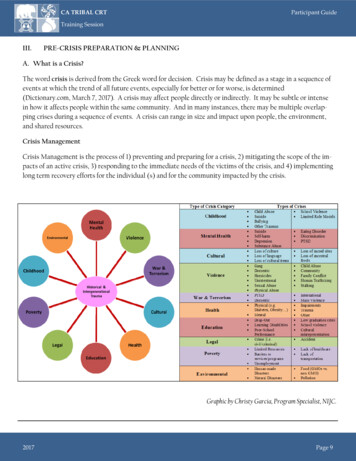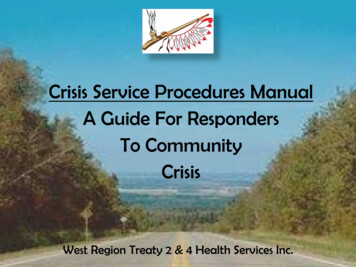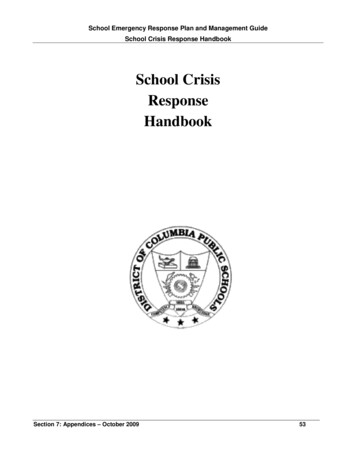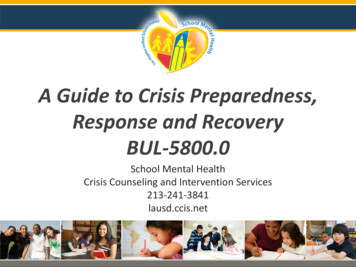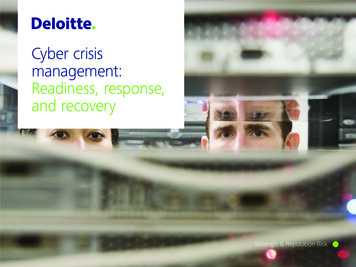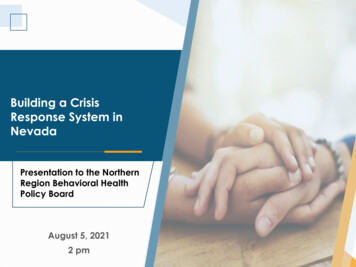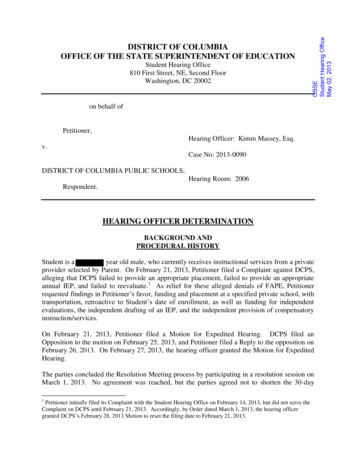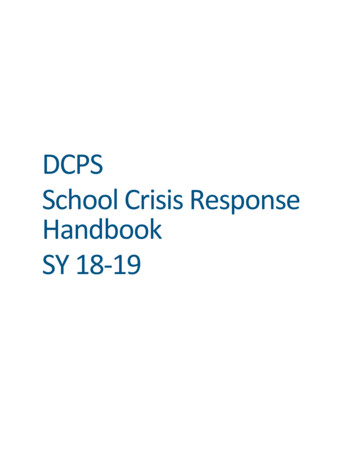
Transcription
DCPSSchool Crisis ResponseHandbookSY 18-19
Table of ContentsI. INTRODUCTIONGlossaryAnnual Training RequirementII. PROCEDURESDCPS Crisis Response ProtocolPre-Crisis PlanningDCPS School Crisis Response Plan TemplateRoles and Responsibilities During a CrisisIndividual Student Crisis ProtocolIndividual Student Crisis Plan Templates (Two Options)Roles and Responsibilities During an Individual Student CrisisChild and Adolescent Mobile Crisis Services (ChAMPS) Flow ChartMetropolitan Police Department StatementThreat AssessmentData Management and ReportingUse of Accelify for Crisis DocumentationIII. FORMS and REFERENCE MATERIALSCritical Incident Response Request: Phone –Based Needs AssessmentNeeds Assessment Planning and Intervention RecommendationsDaily Intervention SheetCentral Crisis Team Sign-In SheetCrisis Response Student Sign-In SheetCrisis Response Follow-Up Student Identification SheetCritical Incident After-ReportSummary of InterventionsFollow-Up Recommendations for Response SiteCrisis Team DebriefingIV. RESOURCES TO ASSIST IN RESPONDING TO A CRISISCommunity ResourcesGeneral Reactions to DeathStudent Reactions to SuicideGuidelines for Making a ReferralSample Script for Faculty Information MeetingStrategies for School Staff When Dealing with a CrisisInstructions for TeachersGuidelines for Classroom PresentationsSample Script for Classroom PresentationsMemorial GuidelinesGuidelines for School Personnel Regarding Suicide and Suicide PreventionSuicide Attempt in ProgressWhat to Do When a Suicide Crisis is OverHow Clinicians Can Support a Teacher Who Has a High-Risk Student Who Returns to ClassSuicide Risk Assessment ChecklistFollow through Steps after Assessing Suicide RiskV. 949515254555657585961626365656667682
I. IntroductionThe primary purpose of this DCPS Crisis Response Handbook is to assist school staff and administration inmanaging school crises in a universal, consistent, and appropriate manner. This manual is intended tocreate and foster a proactive approach to potential crises in schools. It prepares the entire schoolcommunity to cope with the possible impact of a destabilizing occurrence. What makes this manualespecially valuable is that it can be applied and adapted to the particular culture and organizationalstructure of each school. The DCPS Crisis Response Handbook is not intended to supersede The SchoolEmergency Response Plan and Management Guide but acts as an adjunct protocol in protecting andinsuring optimal mental health in response to crisis as defined.This handbook includes suggested procedures and resources to guide the School Crisis Team. Allresponses to crisis situations promote the school system's goal of a safe and orderly learning environmentby reducing the impact of trauma, grief and loss that interferes with normal school functioning and thelearning process.Materials compiled in this handbook were adapted from resources used in Howard County Public Schools,Montgomery County Public Schools, Fairfax County Public Schools, and the D. C. Department of BehavioralHealth - School Mental Health Program as well as past D. C. Public Schools Crisis Response Handbooks.3
Glossary of Terms Used in the DCPS Crisis Response ProtocolSafety PlanningDeveloping a plan to help a student and his/her peers remain safe.Crisis InterventionResponse to a singular incident to immediately address widespread anxiety and/or prevent furtherescalation.Threat ManagementA duty to warn based upon a student’s, staff or visitor’s verbalization and/or observed behavior.Crisis RecoveryRecovery is the ongoing process of restoring the social and emotional equilibrium of the schoolcommunity by promoting positive coping skills and resilience in students and adults. The rate ofrecovery will vary from person to person, depending upon factors such as age, gender, degree of directexposure to violence, death or injury of a friend or family member, previous traumatic life experiences,and pre-existing history of anxiety and depression.The good news is that most students and staff do recover with the support and assistance of caringeducators and mental health professionals. The process of recovery is aided when students and staff cananticipate the stages of recovery and prepare for the normal changes in behavior, thinking, emotion,and spirit that occur over time.Central Crisis Response CoordinatorThis position is held by a Program Manager. The Coordinator is the liaison to School Operations;manages the weekly rotation and crisis database; is responsible for the deployment of clinicians; andensures all necessary supports have been provided to schools.School Crisis Team (SCT) - Mental Health Crisis Response, Recovery PhaseThe SCT may consist of administrative team members, on-site Social Worker, School Counselor, SchoolPsychologist, Nurse, DBH SMHP, health/physical education teacher, peer mediation coordinator, and onsite community mental health providers.SCT ChairpersonThis position may be designated by the school principal or by the SCT, with the principal’s approval. Theresponsibility is carried throughout the year or as required by the principal.Central Crisis Team consists of trained DCPS Social Workers, School Psychologists and School Counselorsas well as school mental health providers from the Department of Behavioral Health.4
Crisis LeadThis position is specific to a Level 2 or Level 3 crisis response. The Crisis Lead is identified at the time ofthe crisis response. The primary responsibility of this position is to insure communication with all relevantentities, and to document data and follow up activity post response.Department of Behavioral Health (DBH) School Mental Health Program (SMHP)DBH SMHPs are clinical staff co-located in school sites as direct providers of mental health services.Children and Adolescent Mobile Psychiatric Services (ChAMPS) of Catholic CharitiesThis service is designed to help children manage extreme emotional behavior. Please review theprotocol for accessing this community-based service.Crisis Response Level of Need:Level 1: School Based Response to a Crisis Event - [School Crisis Team (SCT) responds]Level 1 crises impact part or all of the general school community but do not warrant externalsupport to address the resulting emotional impact. Example: The death of a staff personfollowing a long illness.Level 1 crises also encompass Individual Student Crisis: Individual Student Crisis relates tocritical behavior of an individual student which may be a manifestation of disability; substanceuse impairment or overdose; or other aberrant behaviors with indeterminate causality.Level 2: Central Crisis Team Response to a Crisis Event – [SCT and Central Crisis Team (CCT)both respond. DBH may be called for additional support]Level 2 crises have been assessed to require external support in addressing the mental healthresponse to an event or trauma. Example: The unexpected death of a current student or staffmember on or off campus.Level 3: DCPS/DBH Team Response to a Major Emergency or Community Crisis Event – [SCT,CCT and DBH respond]Level 3 crises require total support of school based, central office and DBH mental healthclinicians (“all hands”) to address a catastrophic event. Examples: School shooting; communitydisaster such as a major fire; natural disaster or terrorism.5
ANNUAL MENTAL HEALTH CRISIS RESPONSE TRAININGAll DCPS School Social Workers, School Psychologists and Counselors are required to complete an online training and post-test. At the start of each school year your assigned Program Manager will sharethe links to those resources and the due dates. This is to ensure the entire workforce is prepared tosupport local schools experiencing a mental health crisis.Professionals providing direct and ancillary support to the mental health teams will have access totraining and may be required to provide certificates of completion to their respective managers. Theseprofessionals may include, Nurses, Security Officers, Special Police Officers, School Resource Officersand others identified by school administration and/or Instructional Superintendents.6
II. PROCEDURES7
DCPS Crisis Response Protocol-Recovery PhaseA coordinated effort within each school, across all schools and with Department of Behavioral Healthis necessary to effectively support the school community in crisis. We accomplish this byimplementing three key strategies:1. All Social Workers, School Psychologists and School Counselors serve on the Central crisis team(CCT).2. Each school has a crisis response plan and designated Lead for the school crisis team (SCT).3. Central office conducts training and provides tools to support schools effectively.DCPS will utilize all Social Workers, School Psychologists, and School Counselors (hereinafter known as“clinicians”) as part of the CCT. This will allow for ample support if there are multiple crises or a largeintervention is required. Each week, a team of 15 providers are “on call”: 7 School Social Workers4 School Psychologists4 School CounselorsClinicians will be on rotation no more than 3 weeks each school year. You will receive notification fromAccelify one week prior to your rotation, and again three days prior to your rotation. Please notify yourPrincipal when you receive this notification, as they are not notified directly via Accelify.If you will be on scheduled leave during this time, please contact Carla Hall (Carla.Hall2@dc.gov) orKenya Coleman (Kenya.Coleman@dc.gov) so that we may schedule an alternate to ensure adequatecoverage.The day you are deployed to a crisis, the only allowable excuses are as follows: A personal crisisJury Duty/Court Appearance*** The review of this Handbook and completion of the associated post-test serves as verbal warningif a crisis deployment is missed, as per the progressive discipline policy. If you do not respond to adeployment, a written warning letter will be distributed by your Program Manager to you, yourPrincipal, and Dr. Bryant-Mallory. ***The option to access Department of Behavioral Health clinicians remains. The Crisis Lead is designateddepending on the nature of the response. Principals and clinicians will receive the on-call schedule bythe start of the school year.The Extended Year (EY) and Extended School Year (ESY) programs will have mental health crisis responsecoverage. Clinicians working during the summer months will be entered into a weekly rotation.Consideration will be made for program coverage.8
Each school has a crisis response plan and designated Chairperson. Many crises can be handledeffectively with existing school staff. Principals’ preparations include:Completing the preplanning formIdentifying all School Crisis Team (SCT) membersAppointing a SCT ChairpersonWhat is a crisis?Crisis is defined as an event that produces a temporary state of psychological disequilibrium and asubsequent state of emotional turmoil that disrupts the educational program. Examples of a crisisinclude, but are not limited to: A death or other traumatic event involving a student or staff memberthat interrupts the normal day-to-day functioning of the school.Who is responsible for responding to a crisis?Each school has a School Crisis Team comprised of the Principal, Assistant Principal(s), Social Worker(s),School Psychologist, School Counselor(s), health assistant and/or Nurse and the Department ofBehavioral Health School Mental Health Provider (DBH SMHP.) One of these team members should beidentified as the School Crisis Team Chairperson, exclusive of the DBH SMHP. School-based teamsprovide prevention information, intervention, and support to school staff, students, and parents duringand in the aftermath of a crisis or traumatic event. This team is also responsible for deciding if additionalsupport is needed from the Central Crisis Team.When is the Central Crisis Team contacted?The decision to contact the Central Crisis Team is made by the Principal, in consultation with theChairperson of the School Crisis Team and the Central Crisis Response Coordinator. If it is determinedthat additional support is necessary, the Central Crisis Response Coordinator contacts the appropriatecentral crisis team members. The role of the Central Crisis Team is to provide consultation andsupport to the SCT. The Central Crisis Team is comprised of Social Workers, School Psychologists andSchool Counselors from DCPS and DBH SMHP who have training and expertise in the area of crisismanagement. The Central Crisis Response Coordinators remains available for consultation.1. The school Principal will identify all school-based team members who will be responsible forcoordinating the school's crisis response, and post their names and contact information aroundthe school. The Principal will either serve as chair of this School Crisis Team or designate a teammember to serve as the chairperson.2. The Principal/Designee will assess the impact of the crisis on the school community and itspotential effect on students, staff, parents and local community members.3. The Principal/Designee will contact the following to inform of the crisis event and giveassessment information:9
Instructional SuperintendentSchool Operations - 202-442-5192DCPS Communications Team – Shakera Tyler (shakera.tyler@dc.gov) or 202-5788930) *The School-Based Mental Health Team should not develop or send anycommunication out to families that has not been vetted by the DCPSCommunications Team.Program Manager for School Mental Health (one is designate on-call each month) at202-505-0733.4. The Central Crisis Response Coordinator will assess the Crisis Response Level of Need*** anddeploy Central Crisis Team members to school.5. The Central Crisis Response Coordinator will assign and deploy one Central Crisis Team memberas Crisis Lead.6. Central Crisis Team members will reassess the situation with the School Crisis Team andPrincipal. The Crisis Response Coordinator and/or Crisis Lead work collaboratively with SchoolOperations and School Safety and Security.7. Central Crisis Team members will coordinate the on-site interventions with School Crisis Teammembers with input from the Principal/Designee.8. If deemed necessary, Central Crisis Team members will bring other trained and certified mentalhealth personnel to create and implement a plan of action.9. Principal, School Crisis Team and Central Crisis Team members will provide up-to-dateinformation to staff regarding the crisis, the plan of action, and any other relevant information.10. Interventions with students include debriefing, counseling, and/or support according to the planof action.11. Interventions with staff include debriefing, counseling, and/or support according to the plan ofaction.12. Appropriate correspondence will be sent to parents and community.13. Follow-up services for students will be planned and scheduled.14. The Crisis team will be debriefed by the crisis response Lead and/or crisis response Coordinator.15. Documentation of the incident will be completed by the designated crisis response Lead orCoordinator in Accelify.10
Pre-Crisis Planning1. The school Principal will identify all school-based team members who will be responsible forcoordinating the school’s crisis response and post their names around the school. The Principal willeither serve as chair of this School Crisis Team or designate a chairperson. The Principal will meetwith the team to discuss their roles and responsibilities and to review the pre-crisis planningprocess.2. Identify staff with skills in medical care.3. Prepare a Telephone Tree. AdministratorSchool Social WorkerSchool CounselorSchool PsychologistHealth Assistant/NurseDBH SMHPOther Staff4. Assemble and distribute crisis intervention packets and related materials. Determine the materials needed including maps of the school building, lists of teachers/roomassignments, copies of the bell schedule including lunch and recess times, name tags, tissues,crayons, markers, construction paper, and copies of yearbooks or memory books.Determine where these materials will be stored, such as in the front office and/or guidanceoffice.List of School Crisis Team Members.5. Designate a location for crisis intervention support*. *Determine where crisis team members will meet with students/staff individually or in groups.Determine the sign-in procedures for visitors.Determine where parents will meet if they arrive at the school.Determine where crisis team members will meet to plan and have access to a telephone.The space should be clearly designated and understood as inviolate by school staff during crisis support.11
District of Columbia Public SchoolsSchool Crisis Response PlanRecovery Phase1. Identify School Crisis Team MembersName & TitleAssignmentOperations ionsEvacuation /ShelteringStudent Accounting & ReleaseSecurityInformation (Telephone)Medical ResponseSupport Counseling2. Identify Staff with Skills in Medical CareNameRoom #Training Certification12
3. Prepare a Telephone Tree: Begin with your Administrator, who will contact theInstructional Superintendent and Security Personnel immediately. The Administratoralso will contact the Crisis Response Chairperson, who then reaches out to all otherinvolved parties.4. Identify Bilingual Staff membersNameRoom #Languages5. Student and Staff who need Special Assistance in EvacuationNameGrade/Homeroom #Assistance Needed/Person Assigned to Assist6. Location of Crisis Support (Crisis Support Location: )Adapted from the Jefferson County Public School Crisis Management Plan13
Roles and Responsibilities during a CrisisA number of roles should be performed by designated personnel. This list represents, at a minimum,what responsibilities key personnel have in responding to a crisis.Administrator only: Verify facts of crisis incident.Authorize intervention efforts.Consult with school security to assure the safety of the students, staff, and community.Notify appropriate central office personnel of crisis incident and other affected schools.Notify school-based administrators and school-based student services personnel of crisisincident.Initiate phone tree for school-based personnel.Be highly visible; show presence, support and control of crisis.Facilitate before school faculty informational meeting.Keep all teachers and other school-based personnel updated on facts, events, circumstances,funeral arrangements, etc.Inform parents of facts, events, circumstances, funeral arrangements, etc.Provide direction about rescheduling activities.Reschedule activities, appointments, and meetings not of an emergency nature.Consult with public information officer regarding release of information to media and public.School Crisis Team Chairperson and/or Administrator: Help coordinate intervention efforts with Principal approval.Verify facts of crisis incident.Meet to assess the degree of impact and extent of support needed.Assemble School Crisis Team, and, if necessary, the Central Crisis Team.Establish pre-planning meeting time for crisis team members as appropriate.Develop statement to share with teachers and other school –based personnel.Develop statement to share with students.Identify at-risk staff.Provide follow-up, as needed, for staff and students and continue to monitor behavior.Central Crisis Team Lead: Assist in planning, coordinating and provisioning for school-based crisis response.Complete all crisis documentation in a timely fashion.Complete comprehensive post-crisis report in Accelify14
Central Crisis Team: Be available during school hours to assist school-based and central office-based administratorsas well as student services personnel for consultation in the event of a school crisis.Share responsibility outside of school hours for consulting with school-based and central officebased administrators, and student services personnel in the event of a school crisis.Assist in the coordination, planning, and provision of school crisis responses by the Central CrisisTeam.School-Based Social Worker, School Psychologist and/or School Counselor: Support intervention efforts.Reschedule activities, appointments, and meetings not of an emergency nature.Provide individual and group counseling.Maintain a list of students seen by support staff. Make follow-up calls to families of students indistress and recommendations for the family to provide support and/or follow-up.Monitor and provide follow-up services to affected students.Be available to staff and provide support, as needed.Faculty: Provide accurate, factual information to students.Identify students who need support and refer them to school-based support personnel.Facilitate classroom discussions that focus on helping students to cope with the crisis; ifappropriate, provide activities such as artwork or writing to help students cope.Dispel rumors.Answer questions without providing unnecessary details.Model an appropriate grief response and give permission for a range of emotions.Structure classroom activities, postpone and reschedule tests, quizzes, and assignments, asappropriate.Nurse /Physical Education Leader (in absence of Nurse): Administer first aid.Request that paramedics and an ambulance be called, as necessary.Appoint someone to meet paramedics at the designated spot and give directions to the locationof the injured.Arrange for someone to travel with students to the hospital, as appropriate.Call for additional school nursing assistance, as needed.Ask for coverage by a Principal's designee if the Nurse is needed elsewhere.Refer distressed students and faculty to school-based support personnel.15
Office Staff: Provide accurate, factual information, via written statement, to inquiring parents andcommunity members.Supervise visitor sign-in procedures.Direct central office and Central Crisis Team members to appropriate locations.Refer distressed students and faculty to school-based support personnel.Provide secretarial support to School Crisis Team and Central Crisis Team members, such ascopying, as needed.16
Individual Student CrisisThe preceding logistical guidelines are applicable in the instance of an individual student crisis with theexception of the deployment of the Central Crisis Team. This protocol is designed to give specificguidance for those instances of aggressive or passive behavior that is problematic for the student andthe school community.What constitutes an individual student crisis? Student runs out of the buildingOut of control behavior that does not de-escalate spontaneouslyExpression (verbal, physical) of self-injury or harm to othersSevere aggression toward peers (stabbing, weapons)Drawings of self-injury or homicidal intentVictims of abuse (physical and sexual)Symptoms of psychosisSymptoms of alcohol or chemical intoxication/overdosePassive, withdrawn, isolative behavior (depression, suicidality)Weapons (possession)SIGNS OF DEPRESSION OR SEVERE EMOTIONAL DISTRESSLOW SELF-ESTEEM; A POOR SELF-CONCEPTMay make self-critical remarks like, “I’m no good, or I’m just a burden.” Considers self a failure; guilty ofsome wrong Says, “I can never do anything right.” A series of crisis events may have happened, which leadsto feelings of haplessness.SENSE OF HOPELESSNESS AND HELPLESSNESSCannot think of any way to make things better; perceives no hope in sight (tunnel vision) even whenalternatives exist; despondent about the future.SHAME, HUMILIATION, OR EMBARRASSMENTLoss of face among peers is a critical problem for youth to cope with. May think that others dislike him/her orare talking about him/her.LISTLESSNESS, TENSION, IRRITABILITYMay react impulsively or be upset about seemingly small events; quick anger.SELF-DESTRUCTIVE THOUGHTS MAY BE EXPRESSEDIntensity and frequency may vary as well as direct or indirect expression.OVERT SADNESS AND DEPRESSIONMay often appear sad and depressed or show signs of tension and extreme anxiety.ACTING OUT BEHAVIORS THAT MAY MASK DEPRESSIONChemical use, refusal to go to school, sexual promiscuity, running away, fighting, recklessness, delinquency,preoccupation with hostility or revenge.UNUSUAL CHANGES IN EATING OR SLEEPING PATTERNSNoticeable decrease or increase in appetite with significant weight change. Anorexia or bulimia are extremeexamples.SUDDEN PERSONALITY CHANGESShy, reserved persons may become aggressive or impulsive. Cautious persons may engage in risk-taking orfighting. Generally inactive persons may become hyperactive. Normally gregarious persons may become shy,withdrawn, or isolated.17
NEGLECT OF PERSONAL APPEARANCEFormerly well-groomed person may become apathetic about personal appearance and hygiene.ISOLATION AND SOCIAL WITHDRAWALWithdrawal from friends, family, and activities formerly enjoyed. May stay in room listening to music withdepressing or suicidal themes that intensify mood.UNCHARACTERISTIC DECLINE IN ACADEMIC PERFORMANCEMay suddenly appear disinterested in school or in future goals. May make remarks like, “Don’t bother tograde my final, I won’t be around,” or “It’s just not worth it.” An unusual decline in grades may be anindication that something is troubling a student.REVERSAL IN VALUATIONSudden change from loving to hating someone, from self-respect to self-hate.DIFFICULTY IN CONCENTRATING; PERSISTENT BOREDOMDifficulty in completing tasks or in following through on assignments. May be consistently unable to keepmind on tasks at hand. May appear to think and act very slowly. Simple, everyday decisions may becomedifficult.VAGUE OR UNEXPLAINABLE PHYSICAL COMPLAINTSHeadaches or stomachaches that visits to a physician do not solve; frequent desire to visit a physician.OUT OF TOUCH WITH REALITYMay be symptomatic of mental illness or chemical use. May also be indicative of a preoccupation withfantasy role-playing games.PREOCCUPATION WITH FATALISTIC OR MORBID THOUGHTSExcessive thoughts about death or suicide, which may show up in written assignments, drawings, choice ofmusic, literature, or other activities.EXPERIMENTATION WITH SELF-DESTRUCTIVE ACTSVery dangerous sign. May make superficial cuts on wrists, drive fast and recklessly, burn or otherwisemutilate body, may become very “accident-prone”.SOURCE: 21009%20-%20Final%20Copy.pdfAn individual student in crisis may cause severe disruption and a possible threat to safety of self andothers. Each school must have a plan to address these potential instances. The most basic plan woulddetail how members of the mental health team are accessed for timely response. Another facet of theplan may address a particular issue, for example: An elementary school has a number of exits and ahistory of absconding. A school wide plan for immediate notification is developed.Plans should also include expectations for support from and interactions with other school basedprofessionals. Communications among the various disciplines- teachers, administrators, mental healthteams, health and security must remain open and constant. Some students for which the need for crisissupport is known will ease this planning process, however there may remain other instances equally ascritical.18
The Point of Contact (POC) (and backup POC)- The clinician who completes the initial assessment. ThePOC’s primary responsibilities are to:1. Assess2. De-escalate3. Create a crisis planSchool Crisis Team or other supportive individuals identified in the school plan:1. Communicate with school administrator2. Contact parents3. Assist in securing safe environment4. Contact ChAMPS, if directedCrisis Team Chairperson:1. Responsible for managing de-briefing, reporting data and crisis follow-up data.2. Responsible for contacting the crisis coordinator if the crisis requires intervention that cannotbe provided in the school setting (per e.g. child to hospital with parent or ChAMPS called)There are some important caveats to consider in these critical situations. Parents must be notified and all efforts to contact parents exhaustedAll “out of control” behavior is not psychiatric or criminal in natureThe role of ChAMPS is not to hospitalize children but to assist in maintaining the student in theschool environment, School Crisis Teams are first respondersResolution of these crises is best achieved through teamworkDe-briefing and crisis planning are integral to the process19
DCPS Individual Student Safety Plan – Option 1If school personnel learn that an individual student is exhibiting behavior that could result in harm tothemselves or others, the following steps should be taken. Examples of an individual student crisissituation could be a student coming to school intoxicated, experiencing homicidal ideation,experiencing suicidal ideation, etc.a) The staff member should IMMEDIATELY notify the Principal or Principal’s designee, and a schoolmental health professional. List the school-based mental health professionals you have in yourbuilding and how they can be contacted:NameTitleHow to Contact*** If none of the above school mental health professionals are on site, DO NOT CALL MPD. Contact theSchool Mental Health Program Manager who is on-call at 202-505-0733.b) The school mental health professional will privately question the student and assess theestimated level of risk. This conversation should be documented.c)The Principal or Principal’s designee, and/or a school mental health professional should call thecustodial parent or guardian and ask him or her to come to the school immediately. If thestudent is age 18 or older or is emancipated, the student will be asked permission to contact aparent or someone else who resides in their household.d) School personnel should continue to supervise the student until parents can be contacted. Thestudent should
The role of the Central Crisis Team is to provide consultation and support to the SCT. The Central Crisis Team is comprised of Social Workers, School Psychologists and School Counselors from DCPS and DBH SMHP who have training and expertise in the area of crisis management. The Central Crisis Response Coordinators remains available for .
